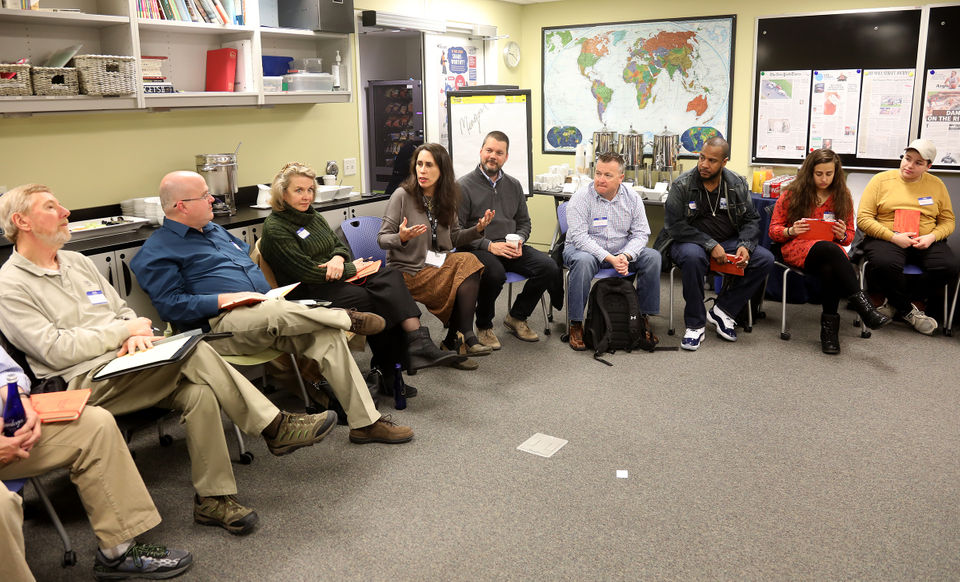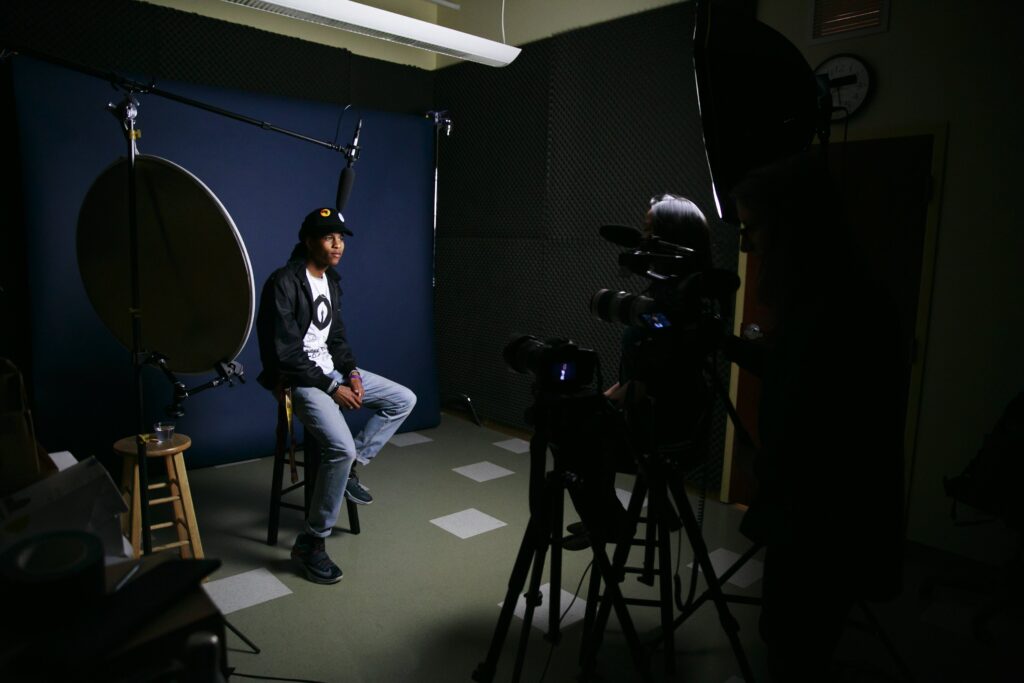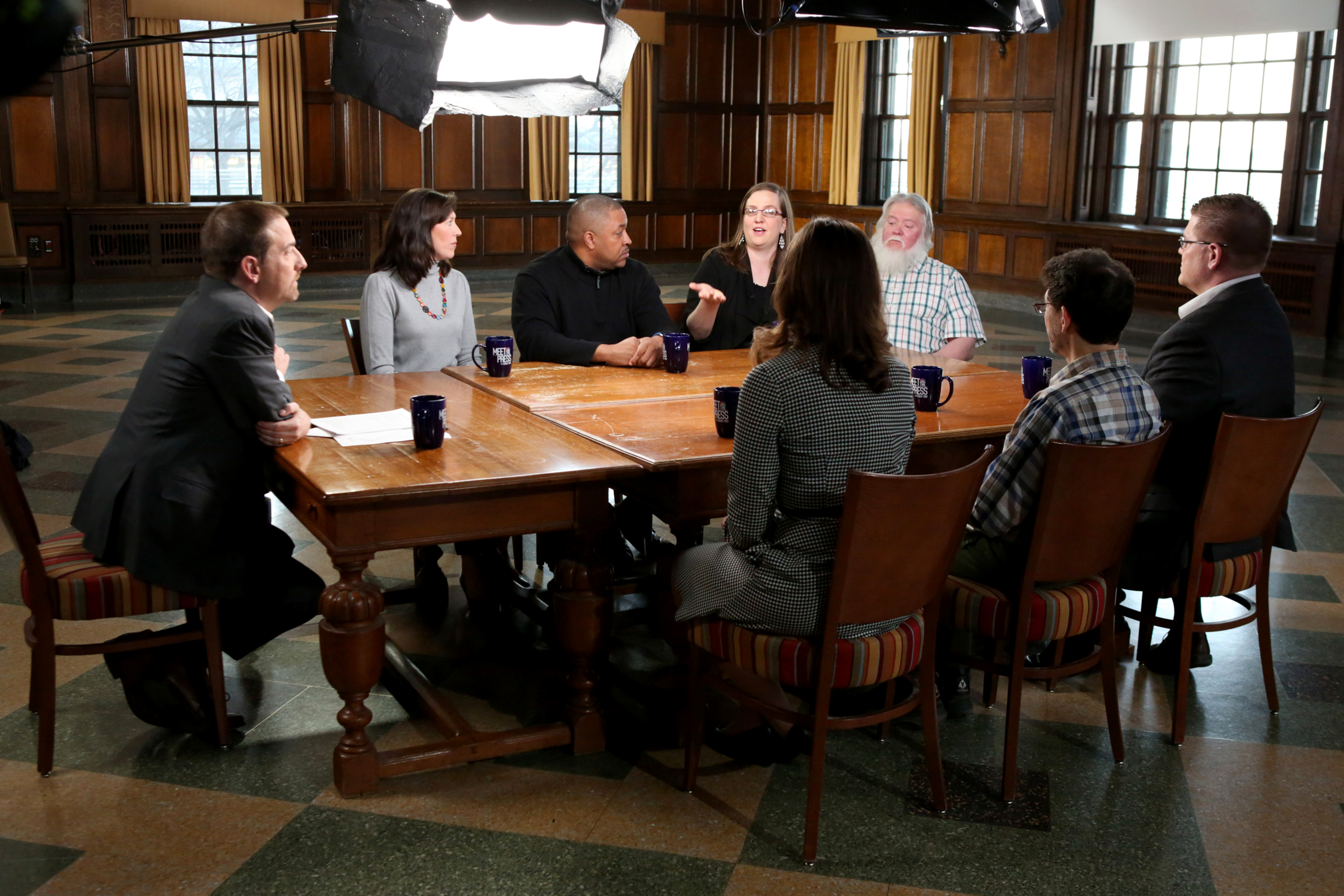On a Sunday morning this past spring, while the talking heads of cable news were slugging it out on opposite sides of the ever-growing partisan divide, seven citizens on NBC’s “Meet the Press” did something astonishing: They listened to each other.
In a segment from Madison, Wisconsin, host Chuck Todd described the panel as “three pro-gun Republicans, three Democrats, and one independent who served in the military.”
In the full discussion, available online, he asked: “Does America have a gun problem? Does anybody here disagree with that?”
No one did.
The “Meet the Press” segment on guns illustrates a new trend in journalism aimed at reducing the animosity in public discourse
And, although they had starkly different ideas on how to solve the problem, there was no yelling, cross talking, or insults during the 17-minute extended discussion on gun control that was posted online.
“As a journalist, you can’t just sit in the observation tower anymore and report that one side is saying this and the other side is saying that,” Todd says. Listening to community voices and encouraging them to listen to each other is not a new tactic in journalism, he adds, “it’s just more of a necessity than before.”
Although “Meet the Press” sits squarely at the center of the legacy media—it first aired in 1947 and is the longest running show on television—the segment on guns illustrates a new trend in journalism aimed at reducing the animosity in public discourse.
The startup Spaceship Media calls it “dialogue journalism” and is trademarking the process it uses to bridge divides. Other efforts include a new StoryCorps feature with intimate conversations between political opposites and a Reddit page at The Seattle Times that ran with a series on race called “Under Our Skin.” Facebook, where Russia-financed vitriol helped to inflame hatred before the 2016 election, hosts issue pages moderated by journalists on topics such as health care, and hyperlocal discussion groups about schools and town elections run by citizen volunteers.
Spaceship Media, which has formed partnerships with news organizations across the country, is arguably the biggest player in the field. Based in Emeryville, California, its small staff promotes the idea of reporters as moderators and active participants in the news, not simply observers and chroniclers. The goals are lofty: to bridge the partisan divide, rebuild trust in news organizations hounded by charges of “fake news,” and ultimately to attract and engage enough readers, viewers, and subscribers to ensure the survival of a struggling industry.
“Whatever we’re doing in the media isn’t working,” says Spaceship Media co-founder Eve Pearlman. “If journalism were doing its job in this country, arguably, we would not be in this position. People would trust the information we provide. We are doing what we can do to fix it.”
This kind of public service approach has its roots in the civic journalism of the 1990s. Controversial at the time for crossing into advocacy and activism, civic journalism asked citizens about their concerns—and incorporated their answers into news coverage that focused on defining solutions, not problems. The 21st- century version is more technologically sophisticated and steeped in social media. It is also less controversial in newsrooms that are looking for any way to stay relevant.
Former Knight Ridder newspaper executive Paula Ellis calls companies like Spaceship Media “disruptors.” They don’t want to blow up journalism, but they do want to challenge some of the traditional orthodoxies that still govern it, such as valuing reports that highlight conflict and “he said/she said” disagreement more than nuance and areas of agreement.
Ellis, now a consultant and a senior associate with the Kettering Foundation, says civic journalism had high-profile detractors who worried that an important line of objectivity had been crossed. Now, she argues, “people are much more open to these ideas of journalist as facilitator. We need watchdogging. I would never back away from that. But there are other roles we can fulfill without compromising our values.”

Practitioners of “dialogue journalism” hope to burst the liberal versus conservative information bubbles and create bonds with their readers that will lead to greater trust. A 2017 Gallup poll found that only 27 percent of Americans said they have a “great deal” or “quite a lot” of confidence in newspapers. But questions remain about the larger goal of these new efforts. Is it simply to foster conversation among alienated groups, or is it to find consensus that leads to policy changes?
Katie Songer, a liberal Democrat, helped found Reach Out Wisconsin with Scott Grabins, a conservative Republican. Both believed in ordinary citizens meeting regularly simply to promote “civil dialogue.” Grabins, a software engingeer, participated in the “Meet the Press” conversation about guns and felt it represented how “we treat people in the group—the Wisconsin nice.”
Songer says the group, made up of Democrats and Republicans in Madison, often grappled with the usefulness of discussing issues with people whose minds they wouldn’t change. “It’s not just about the warm and fuzzy,” she says. “When you’re focused on understanding the other side, ideally you let go of convincing them that you’re right and that creates a space for stumbling across compromises and solutions.”
Songer, who moved from Madison to Portland, Oregon in 2014, welcomes journalists to the work that volunteer citizens have been doing: “Maybe it’s not proper to ask journalists to take on this role, but civil dialogue is one of the most important things we need in this country right now and anyone who can promote it, should.”
Practitioners of dialogue journalism hope to burst the liberal versus conservative information bubbles and create bonds with their readers that will lead to greater trust
Pearlman and colleague Jeremy Hay founded Spaceship Media in November 2016. Both were working for EdSource, which runs an online news source covering public education in California.They were discouraged by “the fractured state of our nation, the breakdown of our role,” says Pearlman. Hay says they wanted to eschew the traditional media mindset of “amplifying difference.” They started thinking how they could do things differently: “careful listening, careful vetting of information and putting our craft to work a little differently,” Pearlman says. They mapped it all out in a Google Doc, then set to work putting their ideas into practice.
Their model is built around four basic questions: What do you think of the other community? What do you think they think of you? What do you want the other side to know about you? What do you want to know about the other community? Those four questions are part of what they now call “the build:” identifying a conflict and building a project around it. They then expand the process into its seven-step “dialogue journalism” method. Its projects, Pearlman says, “convene communities in conflict in moderated conversations, support those conversations with journalism, and partner with existing news organizations to tell stories out of them.”
Among the conversations the company has held: agriculture in Minnesota, guns in America, and the housing crisis in San Francisco. It is now is in the midst of its biggest project yet, “The Many,” which uses a closed Facebook group to bring together women from across the country to discuss their differing political, social, and cultural beliefs.
Adriana Garcia, who spent her career at the New Orleans Times Picayune, is the project’s manager. It began in February, with about 100 women, has now expanded to more than 411 women across 34 states, and continues to grow. The women must fill out a questionnaire and many also do a phone interview before joining the group. About a third of the group’s members identify as Democrats, a third as Republicans, and a third as independents.
Garcia grew up in Arizona among Democrats and is married to a Republican so she has a visceral understanding of crossing divides. She now works with three other moderators to monitor and guide a 24/7 online conversation about the most contentious issues in the public sphere, from guns to abortion to the definition of “privilege.”
One recent poster linked to a Fox News article about Florida high school students staging a walkout in support of gun rights and added this comment: “This is an interesting turn of events. What do you ladies think of students walking out in support of the 2nd Amendment? Should schools give the same amount of support as they did for those protesting guns?” The ensuing discussion was civil and ended this way: “I think it’s fair for both sides to voice their opinions.”
Questions remain about the larger goal of these new efforts. Is it simply to foster conver- sation among alienated groups, or is it to find consensus that leads to policy changes?
But a long thread that bounced off a BuzzFeed question, “How Privileged Are You?” grew so heated that the moderators stepped in repeatedly. “I’m sick of being told I should be ashamed of being white,” one poster commented, while another observed that the first poster’s “prejudice” had blinded her to the value of the quiz. Next came attacks on “deplorables” and “elites” until Garcia and Hay both stepped in and asked people to take a breather and consider “if anything in this conversation affected you in a positive way.”
The Spaceship Media team believes trusted facts are the key to healthy debate. Garcia and other moderators use what they call “FactStacks” to cool heated rhetoric. They are essentially reported stories without the narrative tissue.
Garcia remembers an abortion debate that escalated until women on both sides of the issue began hurling insults. But as they got to know each other, Garcia says, the comments became more personal and more nuanced. Garcia says the comments went from “How can you be killing babies?” to “That was a horrible decision you had to make.” Participants didn’t change their views on abortion, but they were able to discuss them more civilly. “It is really important to remember that for us the goal is not to change minds but for people to be able to engage respectfully,” she says.
Candricka Sutton, a Democrat from Birmingham, Alabama who voted for Hillary Clinton, saw an ad for The Many on Facebook and decided to join. She is African-American and has struggled to understand Trump voters. “I’m trying to heal real-life relationships by having hard conversations in The Many,” she says. “There are some days when I ask myself why I am subjecting myself to this. What’s the end game?”
Teresa Rainey lives in Fairhope, Alabama and decided to join because she spends a lot of time alone at home as a caretaker for her elderly mother and husband. “People have wildly differing opinions,” says Rainey, a white Republican who voted for Jill Stein because she couldn’t vote for Clinton or Trump. “It’s taken a little bit of time for some to be able to converse without getting into an argument. Nobody is going to change anybody’s mind. It’s a lot of easier if you don’t attack and call people names.”
Part of Spaceship’s model is working with traditional media. The Many moderators invite reporters into the group so they can observe conversations and glean story ideas. That’s how Al.com reporter Abbey Crain found the story “Why some Alabama women feel left behind by the #metoo movement,” which chronicles how conservative Alabama women feel at times drawn to, and alienated from, aspects of the growing backlash against sexual assault and harassment.
Crain, a University of Alabama journalism graduate, was the lead reporter on a widely disseminated college newspaper story about discrimination at Alabama sororities. She now covers women’s issues and higher education and checks The Many Facebook page regularly to find story ideas. “Reporters of my generation have always looked to social media to see what people are talking about,” she says. “It’s easy to get the person with the most polarizing response, but it’s important to get the nuanced stories. This really helps dig a layer deeper.”

Finding new ways to listen to the community becomes crucial as local newsrooms shed staff and knowledgeable beat reporters, argues Cole Goins, an independent community engagement consultant and former director of community engagement at The Center for Investigative Reporting’s Reveal. “People are so busy cranking out content they don’t have time to think about engagement, let alone dialogue,” he says.
Jennifer Brandel, co-founder of Hearken, agrees. Hearken, which coined the phrase “public-powered journalism,” partners with news organizations to gather story ideas from the community through a special platform. “Journalists should be activists for communities getting the information they should have,” she says.
If the media’s role as gatekeeper has become anachronistic, are journalists needed to moderate the social media discussion groups that are filling the local news vacuum?
In some cases, journalists spark a conversation that then takes off on its own. In a 2016 project called “Under Our Skin,” for example, The Seattle Times took videos of people responding to 12 phrases including “institutional racism,” “all lives matter,” and “white fragility.” Reporters interviewed people separately but the video looked as if they were having a conversation with each other. The paper also linked to a Reddit page where Times journalists asked members of the public to “Ask Us Anything!” in a Reddit’s “Ask Me Anything” session with both journalists and interview subjects. The “Ask Me Anything” subreddit is one of Reddit’s most popular forums, with about 18 million subscribers.
If the media’s role as gatekeeper has become anachronistic, are journalists needed to moderate the social media discussion groups that are filling the local news vacuum?
In Brookline, Massachusetts, two Facebook discussion groups, started and moderated by concerned citizens, became a source for investigative reporting about local school committee and select board candidates in last spring’s election. The Boston Globe, The Tab newspaper chain, and the online Brookline Patch all cover the community. But the social media groups broke news. Among the information posted: candidates’ voting records, or lack thereof; questions about whether a candidate had inflated his credentials; and detailed accounts of candidates’ positions on the controversial topic of where to build a new school.
The exchanges were often messy. One poster noted a candidate had failed to vote in recent elections—a nugget that would be standard fare for a local paper. But some citizens attacked the disclosure as invasive and irrelevant.
WBUR health and science reporter Carey Goldberg, a Brookline resident, participates in the groups. She also moderates a smaller group connected to her children’s elementary school. After a controversy over the fact that the school was named for an landholder who owned a slave, the town voted to change the school’s name. Goldberg, a former New York Times and Boston Globe reporter, says the groups add value when local news is absent. But they also create challenges because the posters presenting information often have hidden biases.
“When you don’t have a trusted, neutral as possible, journalistic institution, you have all the nastiness of the newspaper comments section, but in addition to that you have people arguing or angling over the actual facts because there is no real correction process,” she says. “You’re left with crowdsourcing accuracy, which is really fraught with inaccuracy.”
Jan Aceti, an energy conservation manager who lives in Brookline, wrote on the townwide discussion group that she was looking for a conservative partner to host a “Red-Blue” workshop run by Better Angels, “a movement to bring liberals and conservatives together to understand each other beyond stereotypes.” Aceti said they hosted the workshop this past summer. Inspired by her brother, David, who is involved in the Reach Out Wisconsin group in Madison, she had already hosted a “civil dialogue” group for 10 months after the 2016 presidential election.
Although she is intrigued by the idea of journalists leading grassroots conversations, she is also wary: “I worry about the mixing of roles of journalist and moderator. If your primary goal is to publish interesting stories, that may take precedence over maintaining good relationships.”
Many news organizations are beginning to view dialogue journalism as a crucial part of editorial innovation and audience engagement
Dave Isay, the founder of StoryCorps, runs an enterprise blending grassroots citizen involvement and journalism. He, too, was so discouraged at the level of discourse after the 2016 presidential election that he felt obliged to try to heal the country’s wounds with a format he has perfected: two human beings speaking face-to-face about the richness and challenges of their lives.
He and the StoryCorps team came up with the “One Small Step” initiative,” which will launch this fall. This initiative will bring together people to “reach across the abyss and get to know someone you thought you hated,” Isay says.
Isay, a MacArthur Fellowship winner, founded StoryCorps in 2003 with a sound booth in New York’s Grand Central Terminal. Edited three-minute versions of selected conversations can be heard on National Public Radio. Unlike Spaceship Media’s initiatives, talking about politics will be forbidden in Isay’s new project. The goal is to connect with another person, not to debate ideas. Someone might answer a question such as “What was a moment that formed your political beliefs?” without getting into a debate about those beliefs. “If the country is headed for a divorce,” Isay says, “then it’s our job to do a bit of marriage counseling.”
Providing counseling to a divided nation may not be a traditional role for journalists. But many news organizations are beginning to view dialogue journalism as a crucial part of editorial innovation and audience engagement—as well as a way to strengthen citizens' trust of the free press, on which so much of civic life depends.



